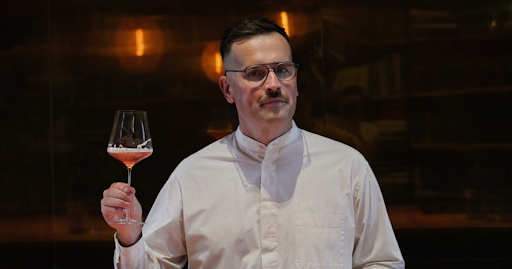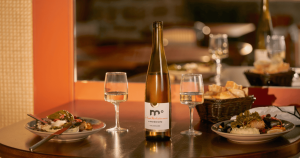Partner Content: Ace of Cups
By Roman Sydorenko, Founder of Ace of Cups
Why do fine dining restaurants—a world obsessed with purity of ingredients and mastery of flavor—continue to rely almost exclusively on wine for beverage pairings? For an industry that prizes precision and sensory depth, this devotion feels increasingly misguided.
Compared to the limited sensory range of wine, tea offers a multidimensional experience. From dry leaves to cold brews, warm infusions, and even as food, tea unveils a spectrum of aromas, flavors, and textures unmatched by any other beverage.
My First Encounter with Extraordinary Tea
 It all started at Sakurai, a minimalist tea bar in Tokyo’s Aoyama neighborhood. It was there that I first encountered Gyokuro—a tea so extraordinary it reshaped my entire perception of what tea could be. Translated as “jade dew,” Gyokuro represents the pinnacle of Japanese tea craftsmanship. About three weeks before harvest, tea plants are shaded from sunlight to soften bitterness and amplify the tea’s natural sweetness and signature umami.
It all started at Sakurai, a minimalist tea bar in Tokyo’s Aoyama neighborhood. It was there that I first encountered Gyokuro—a tea so extraordinary it reshaped my entire perception of what tea could be. Translated as “jade dew,” Gyokuro represents the pinnacle of Japanese tea craftsmanship. About three weeks before harvest, tea plants are shaded from sunlight to soften bitterness and amplify the tea’s natural sweetness and signature umami.
Our experience began with the leaves themselves—perfectly formed, emerald-green needles of the Tsuyuhikari cultivar from the Fukuoka region. Cultivars in tea, much like grape varieties in wine, are specific strains bred to express distinctive characteristics in flavor, aroma, and texture. Handling the leaves was the first ritual—inspecting their texture, marveling at their vibrant hue, and inhaling their deep, vegetal aroma as they gently warmed in the teapot. Six acts of brewing lay ahead, but it was the final one that utterly surprised me. Each brewing temperature revealed a distinct personality, transforming the same leaves into entirely different flavor profiles.
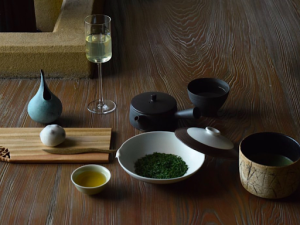 To truly understand and appreciate tea, I believe one must explore its full spectrum—from ice-cold extractions to near-boiling infusions. Our journey began with Gyokuro brewed with cold water, revealing a delicate yet complex profile: soft, sweet, and refreshingly clean with a lingering umami finish. Next, room-temperature water created a rich, broth-like infusion bursting with umami and grassy notes meant to be slowly savored in small sips.
To truly understand and appreciate tea, I believe one must explore its full spectrum—from ice-cold extractions to near-boiling infusions. Our journey began with Gyokuro brewed with cold water, revealing a delicate yet complex profile: soft, sweet, and refreshingly clean with a lingering umami finish. Next, room-temperature water created a rich, broth-like infusion bursting with umami and grassy notes meant to be slowly savored in small sips.
Warm infusions starting at 140°F followed, delivering the gold standard for Gyokuro: a smooth, creamy texture with a perfect balance of umami and grassy sweetness. The experience concluded with an unexpected twist: the infused tea leaves themselves were served as a dish, garnished with soy sauce and citrus. Eating the leaves closed the sensory loop, connecting the visual, aromatic, and tactile elements of the tea in a profoundly satisfying way.
Does Wine Really Enhance Dining?
This transformative experience left me questioning: why not tea instead of wine for fine dining beverage pairings? One of the inherent flaws of wine pairings is alcohol’s impact on human sensory perception. Ethanol, a mild anesthetic, numbs taste buds and mutes the bitter, sour, and umami notes chefs meticulously incorporate into their dishes. Alcohol also dulls taste receptors and dehydrates the palate, diminishing flavor perception. By the second or third glass, its cumulative effects impair both the palate and cognitive clarity, reducing one’s ability to fully appreciate the nuances of the food.
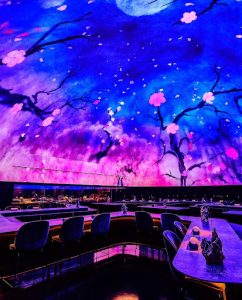
I vividly remember my visit to Alchemist in Copenhagen last August. The six-hour culinary journey, paired with an exceptional non-alcoholic program where fermented teas played a significant role, left me fully immersed in the experience. Meanwhile, the overly generous wine pairings left many diners visibly intoxicated by the final courses—some wobbling as they exited. Watching this unfold, I couldn’t help but wonder how much of the artistry on the plate was truly experienced. By morning, those intricate flavors and textures had likely faded into a blur.
Wine doesn’t need to be the default, nor should it be. A well-crafted non-alcoholic pairing preserves the integrity of the meal, keeping diners sharp and present throughout. I believe the future of beverage pairing lies in drinks that sharpen the senses, not dull them. The best pairings harmonize with the food, enhancing the experience rather than overshadowing it.
Rewriting the Rules: Chefs Embrace the Tea Revolution
Tea in particular offers a pairing experience perfectly suited to modern gastronomy. Its non-alcoholic nature keeps the palate sharp, and its diversity surpasses that of wine. A single tea can evolve dramatically across brewing methods, amplifying the flavors of a dish.
Fortunately, some pioneers in the culinary world are embracing tea as a centerpiece of their beverage programs:
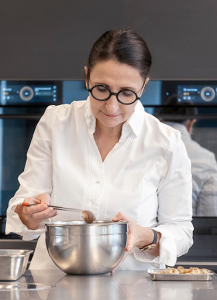 Anne-Sophie Pic, a distinguished French chef, offers an authentic Gyokuro experience as part of the non-alcoholic pairing menu at her three-Michelin-starred restaurant in Valence. Watching the sommelier brew Gyokuro with precision, using a proper pot at the right temperature, was a delightful surprise.
Anne-Sophie Pic, a distinguished French chef, offers an authentic Gyokuro experience as part of the non-alcoholic pairing menu at her three-Michelin-starred restaurant in Valence. Watching the sommelier brew Gyokuro with precision, using a proper pot at the right temperature, was a delightful surprise.
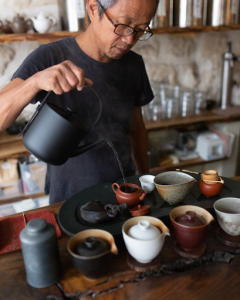 At Yam’Tcha in Paris, chef Adeline Grattard and her husband Chi Wah Chan have taken it further, offering a full tea pairing menu alongside their Franco-Chinese cuisine. Their six-tea line-up includes Tie Guan Yin, a floral and lightly oxidized oolong, Pu’er, an earthy fermented tea and Bai Mu Dan (White Peony), a delicate white tea with subtle sweetness. Chinese cuisine, notoriously difficult to pair with wine, finds a perfect partner in tea.
At Yam’Tcha in Paris, chef Adeline Grattard and her husband Chi Wah Chan have taken it further, offering a full tea pairing menu alongside their Franco-Chinese cuisine. Their six-tea line-up includes Tie Guan Yin, a floral and lightly oxidized oolong, Pu’er, an earthy fermented tea and Bai Mu Dan (White Peony), a delicate white tea with subtle sweetness. Chinese cuisine, notoriously difficult to pair with wine, finds a perfect partner in tea.
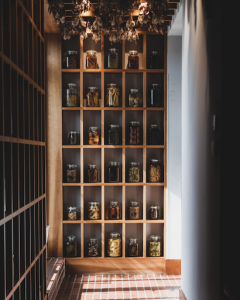 Frantzén in Stockholm, celebrated for redefining fine dining, offers one of the most sophisticated non-alcoholic pairing menus I’ve encountered, easily earning the top spot in my personal rankings. A standout was a meticulously crafted drink featuring Dong Ding tea, oxidized apple, and tsubu arare. The Taiwanese oolong’s floral elegance, gentle smokiness, and roasted undertones harmonized perfectly with the sweetness of oxidized apple.
Frantzén in Stockholm, celebrated for redefining fine dining, offers one of the most sophisticated non-alcoholic pairing menus I’ve encountered, easily earning the top spot in my personal rankings. A standout was a meticulously crafted drink featuring Dong Ding tea, oxidized apple, and tsubu arare. The Taiwanese oolong’s floral elegance, gentle smokiness, and roasted undertones harmonized perfectly with the sweetness of oxidized apple.
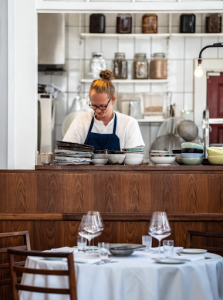 In Copenhagen, AdmiralGade 26 impressed me with its Nordic-Japanese fusion. Their Japanese-inspired Saturday lunch included a homemade cold-brewed deep-steamed fukamushi sencha from Japan, served straight from a HARIO tea bottle.
In Copenhagen, AdmiralGade 26 impressed me with its Nordic-Japanese fusion. Their Japanese-inspired Saturday lunch included a homemade cold-brewed deep-steamed fukamushi sencha from Japan, served straight from a HARIO tea bottle.
Tea Reimagined: Meet the Pioneers
Besides chefs and sommeliers, a new wave of innovative producers in the no- and low-alcohol beverage space is spotlighting tea, crafting sophisticated tea-based wine alternatives. What sets these innovators apart is their reverence for tea’s provenance and the best producers recognize that tea’s story begins with its origin. The interplay of microclimates, cultivars, and centuries-old farming traditions creates both complexity and narrative. Respecting single-origin teas and ensuring ethical sourcing practices are essential to preserving tea’s integrity and honoring the farmers behind it.
Below are a few producers I admire for their innovative approach and dedication to showcasing tea at its finest:
Grands Jardins, an innovative tea company from Paris, specializes in bottled cold-brewed rare teas, such as Ilam from Nepal and Bokeo from Laos.
MURI, based in Copenhagen, Denmark, features cold-brewed Huangshan Mao Feng jasmine tea from Anhui Province, China, as a key layer in Passing Clouds, their flagship blend. This unique creation combines various fermentations, including gooseberries fermented with Pichia kluyveri yeast, quince water kefir, and a kvass infused with woodruff and geranium.
Lao, a Canadian producer of fermented teas, offering two notable expressions: Japanese Gyokuro Okabe, a shaded green tea known for its rich umami and delicate sweetness, and Taiwanese Mucha Tie Guan Yin, a lightly-roasted oolong with floral and nutty undertones.
Unified Ferments is a Brooklyn-based brand specializing in fermented tea beverages made from high-quality teas sourced from China, Taiwan, and India. Their goal is to unpack and translate tea into a novel context.
PROXIES, a Canadian pioneer in non-alcoholic wine alternatives, uses single-origin teas as the foundation of their blends, combining traditional hot and cold extractions. Highlights include Silver Needle from Fujian (Pink Salt, Bubbly Rosé), Sencha Satsuma from Kagoshima (Crisp White), and Bai Mu Dan from Fuding (Gold Crush, Blank Slate).
Leave Your Sword, based in Amsterdam, Netherlands, is an artisanal brewer specializing in unpasteurized, unfiltered fermented teas. My favorites are the High Mountain Taiwanese Oolong and Lapsang Souchong, which deliver unparalleled expressions of these exceptional teas.
AMA Brewery, based in Spain’s Basque Country, crafts fine pét-nat teas through fermentation and aging. Their Elusive Cuvée Vol. 1, made from roasted Hojicha tea from Kyoto, is a standout. It’s my favorite expression of fermented Hojicha to date.
The Tea Revolution is Here
Tea is redefining sophistication in the gourmet world, with Michelin-starred restaurants and innovative producers increasingly embracing its unparalleled versatility and depth. Tea’s ability to enhance the dining experience without overwhelming it makes it a modern, mindful alternative to traditional wine pairings. From single-origin Gyokuro to fermented tea-based wine alternatives, chefs and producers alike are exploring tea’s potential to complement flavors. As tea continues to gain traction in fine dining and beyond, the question is no longer whether it belongs. It’s how soon it will take center stage as a sophisticated, sensory-driven beverage of choice.
For more from Roman, don’t miss his interview with Dry Atlas and his 10 Must-Try Gourmet Specialty Beverages to Outclass Your Wine Lineup. You can also follow his Insights on LinkedIn.
Interested in his beverage investment syndicate, Ace of Cups? Apply to join as an investor or apply to pitch today.


